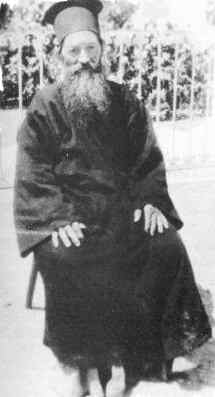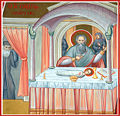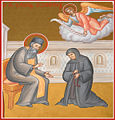Savvas the New of Kalymnos
Our venerable and God-bearing father Saint Savvas of Kalymnos (also known as Saint Savvas the New) is the patron saint of the Greek island of Kalymnos (Calymna), where he lived during the last twenty years of his life as the priest and spiritual father of the nuns of the Convent of All Saints. He was a great ascetic, confessor, iconographer, and miracle-worker. He is one of the recently recognized saints in the Greek Orthodox Church.
He died on April 7, 1947 and his remains were exhumed in 1957 and "miracles happen for those who venerate these in faith". In Kalymnos, he is commemorated by the church April 7. The feasts dates of St. Savvas the New of Kalymnos are celebrated on various dates in different traditions, April 7 (March 25 in the Old Calendar), December 5 with St. Sabbas the Sanctified, and the fifth Sunday of Great Lent with St. Mary of Egypt.
Contents
Life
Saint Savvas was born in 1862 in Herakleitsa, Eastern Thrace to Constantine and Smaragda, very poor and he was their only son. When he was baptized he was given the name Vasilios.
From a young age he had a calling for the holy monastic life and secretely left for Mount Athos at the age of twelve where he entered St. Anne's Skete. Along with the usual monastic duties, this is where he learned iconography and Byzantine music.
After twelve years, he traveled to Jerusalem for a pilgrimage to the holy sites. He arrived in 1887 and entered the monastery of St. George Hozevitou and lived there for seventeen years as a hermit in the deserted and rugged cliffs. After serving for a period as a novice, he was tonsured a monk and given the name Sava.
In 1890, he joined the brotherhood of the Abbott Kallinikos (from Alatsata of Asia Minor) and in 1902 was ordained a deacon. In 1903, a year later, he was ordained to the holy priesthood by Archbishop Nikodemos from Diokesaria. He spent almost 10 years in the desert by the Jordan where he led an austere life and occupied himself with prayer and iconography. His dwelling consisted of two cells which he reached by ascending up a rope ladder. This isolation was necessary for successful inner concentration and noetic prayer and he made great spiritual progress there.
Due to the irregularities caused by the raids of the Arabs in the Holy Land, and health reasons, Sava was forced to leave. He returned to Greece where he searched for a quiet place to continue his monastic life. He was attracted to the island of Patmos, where he lived for a while in the hermitage of Grava and later at the Monastery of St. John. [1]
He later traveled for three years, throughout Greece, looking for a suitable place to stay. He visited Mount Athos, then the Monastery of Phaneromenis, then Salamina and finaly the island of Hydra but in 1919, he was invited to stay at the Greek island of Aegina, by St. Nektarios, to serve as a priest at the Convent of the Holy Trinity, and stayed for six years at this convent (from 1919 until 1925). There he taught the nuns the sacred art of iconography and Byzantine music. This period was one of the most significant events in his biography due to his friendship with St. Nektarios; who was at the height of his spiritual development at this time. Sava had the opportunity to confess and receive counsel from the saint and the two held each other in high esteem and considered each a saint.
Savvas conducted the funeral service for Saint Nektarios and is also renowed for painting the first icon of the saint.
- One day St. Savvas asked the abbess not to let anyone disturb him for forty days, during which he remained confined to his cell in which the nuns could hear constant conversation (between the living Saint and the reposed Saint). After 40 days, he came out of his cell holding an icon of the saint. He handed it to the abbess and asked her to place it in the church for veneration. The abbess was surprised since Nektarios had not been formerly glorified ("canonized") as a saint, and was afraid that the convent would get into trouble. Although Savvas was always meek and humble, he insisted, and told her in a commanding manner: "You must show obedience. Take the icon and place it on the icon stand, and do not scrutinize the will of God." He knew the holiness and purity of St. Nektarios.
After the repose of St. Nektarios, the number of pilgrims to the convent increased due to the growing reputation of the saint as a miracle-worker. This greatly disrupted the quiet life that Savvas loved and with the encouragement of Gerasimos Zervos [2], he departed in 1925 and went to the island of Kalymnos.
There, he spent the last years of his life as the priest and spiritual father at the Convent of All Saints. As a confessor, he combined leniency with severity. He was lenient on certain sins and severe to others. He remained an ardent spiritual striver until the end of life and practiced extreme forms of self-restraint with regard to food, drink, and sleep. St. Savvas became a shining example of virtue to all who came into contact with him. Many smelled a heavenly fragrance in his presence and some even saw him rising above the ground as he stood at prayer.
Towards the end of his life, St. Savvas was in a state of intense prayer and holy contrition. For three days he did not receive anyone and he gave his last counsels: requested love and obedience in Christ. When he was on the point of death taking his last breath, suddenly he received strength, brought his blessed small hands together, and clapped them repeatedly saying his last holy words: "The Lord! The Lord! The Lord!" He went to the Lord in 1947 on the eve of the feast of the Annunciation. One nun saw the soul of the saint ascending in a golden cloud towards heaven. After about 10 years when the saint's grave was opened in accordance to the Greek Orthodox custom, a heavenly fragrance emanated from the grave which covered the whole island of Kalymnos, this phenomenon was witnessed by many, including the local bishop. This was a testament to the sanctity of the saint. Numerous miracles and healings have since been attributed to St. Savvas the New of Kalymnos.
Icons of the Saints Life
- Saint Savvas- St Savvas of Kalymnos-with Icon6X4.jpg
Icon of the Saint holding the first icon of Saint Nectarios.
Photographs of Saint's Monastery
Notes
- ↑ This is verified by an inscription on an icon painted by St. Sava at the monastery "In the month of December in 1914 this icon was painted by the hand of the iconographer, holy monk Savvas the Hosevite."
- ↑ Gerasimos Zervos, the husband of Anna, who later became Sister Monica, who also went to Kalymnos.
Hymns
- Let us faithful praise Holy Savas, the glory and protector of Kalymnos,
- and peer of the Holy Ascetics of old;
- for he has been glorified resplendently as a servant of Christ,
- with the gift of working miracles,
- and he bestows upon all God's grace and mercy.
- Today the island of the Kalymnians celebrates your holy memory with a rejoicing heart;
- for it possesses as truly God-given wealth,
- your sacred body that has been glorified by God, O Father Savas,
- approaching which they receive health of both soul and body.
- Rejoice, thou new star of the Church,
- the offspring of Thrace and the beauty of Kalymnos,
- O God-inspired Savas, fellow citizen of angels and equal of all the saints.
Source
- Modern Orthodox Saints, Vol. 8. "St. Savvas the New" by Dr. Constantine Cavarnos, Institute for Byzantine and Modern Greek Studies ISBN 0914744631
- Photographs & Icons courtesy of Savas Pizanias and Constantine Vellis Cutie-Pie Photography - NSW Australia contact - info@cutiepiephoto.com.au
External links
Categories > Arts
Categories > Arts
Categories > Church History
Categories > Church History
Categories > Church History
Categories > Church History
Categories > Liturgics > About Icons
Categories > Liturgics > Feasts
Categories > Liturgics > Feasts
Categories > Liturgics > Feasts
Categories > Liturgics > Feasts
Categories > Liturgics > Feasts
Categories > OrthodoxWiki > Featured Articles
Categories > People > Iconographers
Categories > People > Monastics
Categories > People > Monastics > Athonite Fathers
Categories > People > Saints
Categories > People > Saints > Greek Saints
Categories > People > Saints > Saints by century > 20th-century saints
Categories > People > Saints > Wonderworkers
Categories > Spirituality > Asceticism
Pages with broken file links


















